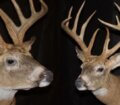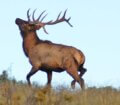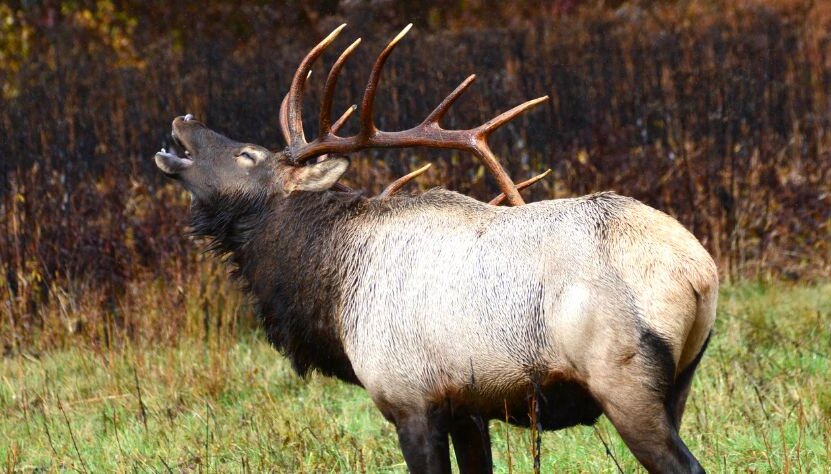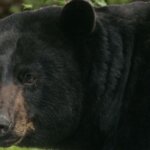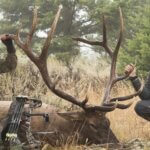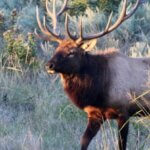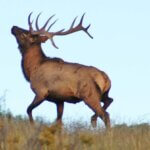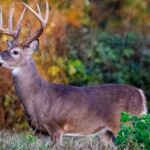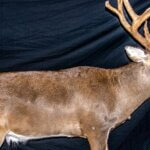Editor’s Note: Outdoorsman Bear Kelly was mentored as a trapper in 1996 by the late Dick Kirby, the creator of Quaker Boy Calls in Orchard Park, New York. Bear is primarily a bowhunter, but he hunts with a gun, a muzzleloader, and a crossbow. He’s hunted in Montana, Wyoming, Colorado, New York, Ohio, Pennsylvania, Alabama, Tennessee, and Canada.
My biggest bow buck scored 152. I took him to New York State near Orchard Park, where I was hunting in a residential area that I’d been permitted to hunt by the town. Orchard Park at that time didn’t have a nuisance trapper, and the town had some property on a creek near where I lived they needed to alter but couldn’t due to beaver activity. One day, town officials came to me and said, “We know you do a lot of trapping,” after that, I became the town’s nuisance trapper. There were 140 acres right across from my house, so the deal I offered them was, “I’ll trap your nuisance animals for the right to bowhunt on the city’s property that’s owned by the town, and that will be my pay for trapping.” The city-owned this land that it had planned some day to construct buildings on and other lands where they planned to build parks. I was permitted to hunt all those outlying properties. So, I swapped trapping beavers for deer hunting on land that no one but me had permission to hunt. I thought that was a fair trade.
Often, I’d see the same big buck in front of my house because there was a 30-acre field on those 140 acres. I could see where he entered and left the field, plus I’d also spot him and numerous deer trails when I was trapping beavers along the creek that ran through the property. I watched this buck grow for several years. I was familiar with his route and could pinpoint the trails he was using. At that time, I had four of the early Moultrie trail cameras.
The day I decided to hunt this buck, I had a favorable wind. I had a Summit climbing tree stand, but I only got up about 12 feet off the ground with it to see over the brush and the undergrowth. I set up on the edge of a hedgerow because the trees there were big enough for me to climb with my tree stand. I picked this stand by identifying the trails the does were using and the trails the bucks were using. I learned that most often, the bucks used trails that weren’t being used by the does. Although several good bucks were on the land, this was the buck I wanted. The city’s property adjoined a cornfield, so the deer had plenty of agriculture to feed on and could bed and feed on natural browse. Due to the houses around the property, the area was an ideal sanctuary.
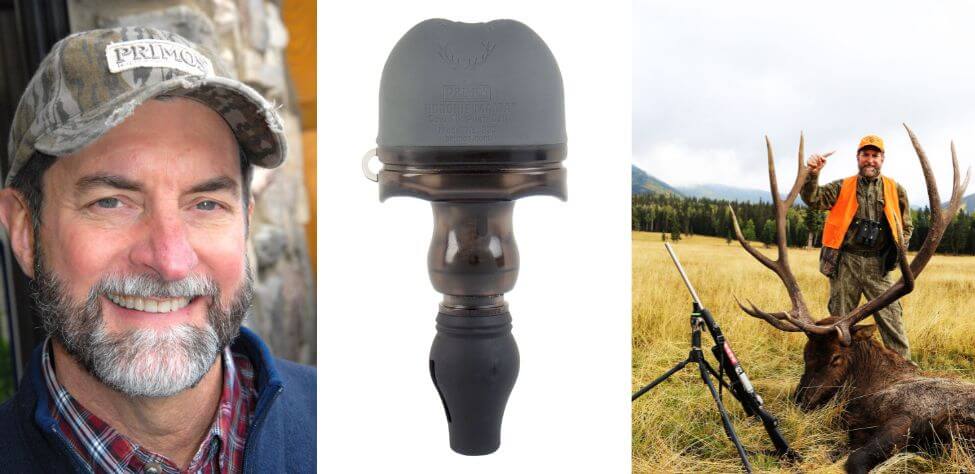
Even though I had a favorable wind that day, I’d learned over the years there’s an advantage to being scent-free since bucks don’t always do what they’re supposed to do. I felt a lot of confidence in being scent-free when hunting, particularly bowhunting. Not only was the wind good while I was hunting this buck, but I also had a day off, so I could devote the entire day to taking the Orchard Park buck. As I sat in my stand, I caught movement off to my left, and when I looked, the buck was walking down the edge of the hedgerow where I’d anticipated he’d come. When he was 18 yards from me, I saw that he had his nose in the air sniffing for an estrous doe.
At that time, my bow of choice was a Hoyt Reaper, and I was shooting a Wasp SST broadhead. I especially liked that broadhead because when it came out of my bow, it flew straighter at long distances than other broadheads I’d shot in the past. When the buck was walking away from me, I drew my bow and then grunted to stop him. He looked back in the direction where he’d heard the grunt call, offering me a perfect broadside shot. The arrow flew true and hit the buck right behind his right shoulder and made a clean pass-through. The buck only ran 20 yards and was down for the count. This hunt occurred late in the morning after all the residents around the property had gone to work. At that time, I was wearing Mossy Oak Break-up, so I was not only invisible to the buck but also to anyone in the neighborhood.
I drove roads into and out of the property where neither I nor my vehicle would be seen. I knew these lands well because my Grandmother Smith owned it initially, and she sold that property to the town to make a park. However, several years went by before the town started building it. That’s why the town wanted the beavers removed from the property. Then, the town could route the stream where they wanted it to go and not have it dammed up and flooding the land. Throughout my arrangement with the city, I removed five beavers from the property.

How to Hunt and Take Big Buck Deer on Small Properties
In this book, you’ll hear from 14 hunters who either have gained permission or leased properties as small as six acres to as much as 250 acres, and how they consistently take older-age-class bucks off these little lands.
VERSIONS: AUDIBLE, KINDLE & PRINT

Jim Crumley’s Secrets of Bowhunting Deer
Using a black magic marker and a gray work jumpsuit, Jim Crumley of Buchanan, Virginia, drastically changed the nature and purpose of hunting camouflage when he created the first sportsman’s camouflage – Trebark. Crumley’s love of bowhunting and his desire to be more invisible changed hunting clothing forever.
In this hunting guide, he shares the wisdom that he’s learned throughout his lifetime about how to be a hunter, how to find a deer lease, how to scout for deer, and more.
Special features include how to:
- Have a magic 60 acres to hunt
- Decide the best equipment to use
- Find deer year-round
- Locate land to hunt
- Know the best place to put your tree stand
- Get bucks within bow range
VERSIONS: AUDIBLE, KINDLE & PRINT

How to Hunt Deer Like a Pro
How do you know if the land you hunt has a trophy deer on it? Wildlife manager Bob Zaiglin, of Uvalde, Texas and Jim Crumley, the father of modern-day hunting camouflage, tells you how to find out. GPS can make finding and taking that trophy buck easier. This hunting guide will teach you how to hunt big bucks where no one else can find them, how to call deer, and how to become versatile as a deer hunter, so that if one deer tactic doesn’t work, another one will.
In the chapter, “How to find Bucks at Scrape,” Dr. Keith Causey, retired professor of Wildlife Science at Auburn University, describes the best way to hunt a scrape.
Brad Harrison of Neosho, Missouri, is a nationally-known videographer, professional deer hunter and master at calling deer. Another master is Will Primos of Primos Game Calls. These two experts will tell the best deer calls and when to use them in this book.
And for over 20 years, Bo Pitman, lodge manager of White Oak Plantation, has been studying deer movement patterns. He explains what types of conditions are best for predicting deer movement.
VERSIONS: AUDIBLE, KINDLE & PRINT

Deer hunting and deer hunters are drastically changing each year. To learn new techniques for hunting deer and have more places to hunt, I’ve interviewed some of the best deer hunters in the nation and share their tactics in How to Hunt Deer Like a Pro: Volume II.
In Chapter 10, Jacob Lamar tells you his tactics for consistently taking older-age-class bucks on public lands in several states. Chapter 11, Bob Walker explains how to find places on public lands where you can hunt that 99 percent of the other hunters never have considered hunting. The Bonus Chapter with David Ramey tells you how, where, when and with what equipment to take big Kansas bucks on public lands by hunting in 100-degree weather when others won’t hunt.
Chapter 13, Mark Drury, his family and his guests take mature bucks every season by having more small places to hunt rather than one large property. Drury explains the strategy of having satellite farms to hunt that only may be 50-150 acres each or less. Chapter 15, Pat Reeve, who hunts far-northern states and Canada, says, “I don’t like hunting for mature bucks until the weather is 20 degrees or less.” Chapter 4, Dr. Larry Marchinton says that funnels are the most-reliable stand sites to hunt for big bucks and tells why.
VERSIONS: AUDIBLE & PRINT
Tomorrow: Preparing for Bow Deer Season

